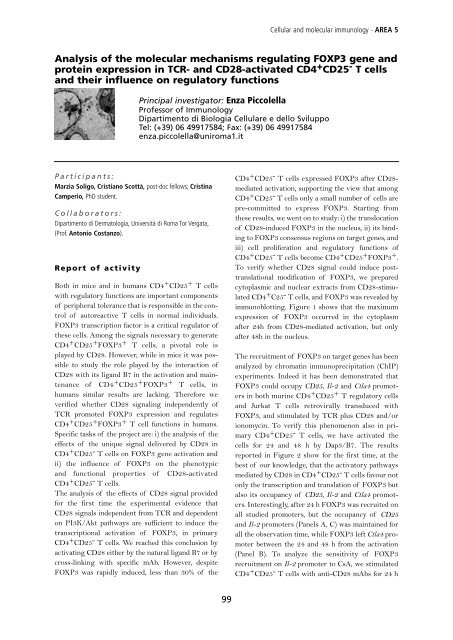download report - Istituto Pasteur
download report - Istituto Pasteur
download report - Istituto Pasteur
Create successful ePaper yourself
Turn your PDF publications into a flip-book with our unique Google optimized e-Paper software.
P a r t i c i p a n t s :<br />
Marzia Soligo, Cristiano Scottà, post-doc fellows; Cristina<br />
Camperio, PhD student.<br />
C o l l a b o r a t o r s :<br />
Dipartimento di Dermatologia, Università di Roma Tor Vergata,<br />
(Prof. Antonio Costanzo).<br />
Report of activity<br />
Both in mice and in humans CD4 + CD25 + T cells<br />
with regulatory functions are important components<br />
of peripheral tolerance that is responsible in the control<br />
of autoreactive T cells in normal individuals.<br />
FOXP3 transcription factor is a critical regulator of<br />
these cells. Among the signals necessary to generate<br />
CD4 + CD25 + FOXP3 + T cells, a pivotal role is<br />
played by CD28. However, while in mice it was possible<br />
to study the role played by the interaction of<br />
CD28 with its ligand B7 in the activation and maintenance<br />
of CD4 + CD25 + FOXP3 + T cells, in<br />
humans similar results are lacking. Therefore we<br />
verified whether CD28 signaling independently of<br />
TCR promoted FOXP3 expression and regulates<br />
CD4 + CD25 + FOXP3 + T cell functions in humans.<br />
Specific tasks of the project are: i) the analysis of the<br />
effects of the unique signal delivered by CD28 in<br />
CD4 + CD25 - T cells on FOXP3 gene activation and<br />
ii) the influence of FOXP3 on the phenotypic<br />
and functional properties of CD28-activated<br />
CD4 + CD25 - T cells.<br />
The analysis of the effects of CD28 signal provided<br />
for the first time the experimental evidence that<br />
CD28 signals independent from TCR and dependent<br />
on PI3K/Akt pathways are sufficient to induce the<br />
transcriptional activation of FOXP3, in primary<br />
CD4 + CD25 - T cells. We reached this conclusion by<br />
activating CD28 either by the natural ligand B7 or by<br />
cross-linking with specific mAb. However, despite<br />
FOXP3 was rapidly induced, less than 30% of the<br />
Principal investigator: Enza Piccolella<br />
Professor of Immunology<br />
Dipartimento di Biologia Cellulare e dello Sviluppo<br />
Tel: (+39) 06 49917584; Fax: (+39) 06 49917584<br />
enza.piccolella@uniroma1.it<br />
99<br />
Cellular and molecular immunology - AREA 5<br />
Analysis of the molecular mechanisms regulating FOXP3 gene and<br />
protein expression in TCR- and CD28-activated CD4 + CD25 - T cells<br />
and their influence on regulatory functions<br />
CD4 + CD25 - T cells expressed FOXP3 after CD28mediated<br />
activation, supporting the view that among<br />
CD4 + CD25 - T cells only a small number of cells are<br />
pre-committed to express FOXP3. Starting from<br />
these results, we went on to study: i) the translocation<br />
of CD28-induced FOXP3 in the nucleus, ii) its binding<br />
to FOXP3 consensus regions on target genes, and<br />
iii) cell proliferation and regulatory functions of<br />
CD4 + CD25 - T cells become CD4 + CD25 + FOXP3 + .<br />
To verify whether CD28 signal could induce posttranslational<br />
modification of FOXP3, we prepared<br />
cytoplasmic and nuclear extracts from CD28-stimulated<br />
CD4 + C25 - T cells, and FOXP3 was revealed by<br />
immunoblotting. Figure 1 shows that the maximum<br />
expression of FOXP3 occurred in the cytoplasm<br />
after 24h from CD28-mediated activation, but only<br />
after 48h in the nucleus.<br />
The recruitment of FOXP3 on target genes has been<br />
analyzed by chromatin immunoprecipitation (ChIP)<br />
experiments. Indeed it has been demonstrated that<br />
FOXP3 could occupy CD25, Il-2 and Ctla4 promoters<br />
in both murine CD4 + CD25 + T regulatory cells<br />
and Jurkat T cells retrovirally transduced with<br />
FOXP3, and stimulated by TCR plus CD28 and/or<br />
ionomycin. To verify this phenomenon also in primary<br />
CD4 + CD25 - T cells, we have activated the<br />
cells for 24 and 48 h by Dap3/B7. The results<br />
<strong>report</strong>ed in Figure 2 show for the first time, at the<br />
best of our knowledge, that the activatory pathways<br />
mediated by CD28 in CD4 + CD25 - T cells favour not<br />
only the transcription and translation of FOXP3 but<br />
also its occupancy of CD25, Il-2 and Ctla4 promoters.<br />
Interestingly, after 24 h FOXP3 was recruited on<br />
all studied promoters, but the occupancy of CD25<br />
and Il-2 promoters (Panels A, C) was maintained for<br />
all the observation time, while FOXP3 left Ctla4 promoter<br />
between the 24 and 48 h from the activation<br />
(Panel B). To analyze the sensitivity of FOXP3<br />
recruitment on Il-2 promoter to CsA, we stimulated<br />
CD4 + CD25 - T cells with anti-CD28 mAbs for 24 h








